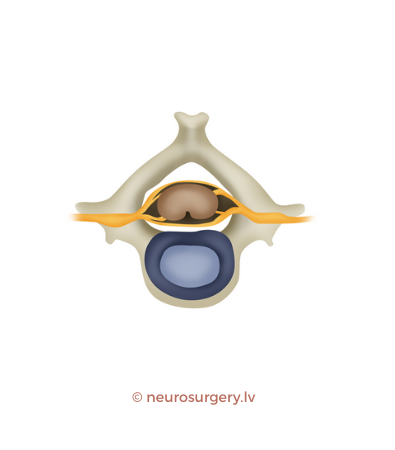Conditions
Cervical stenosis
What is Cervical Stenosis?
One of the spinal column's primary functions is to protect the spinal cord and nerves housed within the spinal canal. When this canal narrows, causing compression of the spinal cord and nerves, the condition is referred to as cervical spinal stenosis.

Picture: cervical spine
Causes of Cervical Stenosis
Like all structures in the body, the spine naturally undergoes wear and tear over time. Spinal degeneration manifests as:
- Intervertebral disc deformities (herniation, protrusions)
- Thickening (hypertrophy) of ligaments
- Enlargement of intervertebral joints
In medical terminology, spinal degeneration is called spondylosis. Spondylosis affects almost every individual past middle age and is considered a normal aging process. However, in cases of excessive degeneration, spinal ligaments and joints thicken, reducing space in the spinal canal and compressing the spinal cord and nerves—this is cervical spinal stenosis.
Lumbar stenosis is also common in individuals who have previously experienced cervical spine injuries.
Symptoms of Cervical Spinal Stenosis
Spinal cord and nerve compression in the cervical region typically affects individuals over 50 years of age. Symptoms may include:
- Neck pain (variable intensity)
- Pain, weakness, numbness in shoulders, arms, or legs
- Clumsiness in hands
- Balance and gait disturbances (small, unsteady steps)
- Reduced walking distance
- Burning sensations or tingling ("pins and needles") in arms or legs
- Severe cases: Leg weakness (paresis, plegia) and/or urinary incontinence
What Should You Do If You Suspect Cervical Spinal Stenosis?
Since other conditions can cause similar symptoms, consulting a neurosurgeon is essential for accurate diagnosis and treatment planning.
Diagnosing Cervical Spinal Stenosis
Diagnosis is based on:
- Characteristic patient symptoms
- Objective findings during examination (muscle weakness, reduced sensation, neurological deficits)
- Radiological imaging (typically MRI, occasionally CT scan, X-ray, or myelography)
If you or a loved one has confirmed or suspected cervical spinal stenosis, a neurosurgical consultation is necessary.
We offer in-person and remote consultations via video calls. Appointments can be scheduled online, via phone, or email. Please contact us to arrange a remote consultation.
Treatment Options for Cervical Spinal Stenosis
In mild cases, symptoms can be effectively managed with:
- Nonsteroidal anti-inflammatory drugs (NSAIDs)
- Limited physical exertion
- Therapeutic neck exercises to strengthen and stabilize the cervical spine
During the acute phase, a semi-rigid or rigid cervical orthosis (neck brace) may be recommended to provide stability and reduce inflammation.
In severe cases or when non-surgical treatment fails, surgery may be necessary to relieve pressure on the spinal cord and nerves.
Surgical Techniques for Cervical Spinal Stenosis
Several surgical procedures aim to expand the spinal canal and decompress the nervous structures, each suited to specific stenosis causes. Your neurosurgeon will discuss the most appropriate approach based on your condition.
Common Surgical Procedures:
-
Decompressive Laminectomy – The most frequently used surgery worldwide for cervical stenosis. This procedure removes part of the vertebral arch (lamina) to increase space in the spinal canal and relieve spinal cord compression. If only part of the lamina is removed, the procedure is called laminotomy.
-
Laminoplasty – A modernized version of laminectomy, where the lamina is expanded instead of removed, preserving posterior spinal ligaments for a more physiological outcome.
-
Anterior Cervical Discectomy and Fusion (ACDF) – Recommended when intervertebral disc deformities (herniation, protrusion) contribute to stenosis. The damaged disc is removed, decompressing the spinal cord and nerves, and replaced with an artificial disc implant.
-
Cervical Foraminotomy – If narrowing affects the area where nerves exit the spinal canal (foraminal openings), a foraminotomy may be performed to relieve nerve compression.
While cervical stenosis surgery is considered highly safe, like all procedures, it carries potential risks. Learn more about possible surgical complications.
Our surgical facility, where procedures and interventions take place, is the modern, well-equipped Aiwa Clinic.
What Does Surgery Mean for the Patient?
Thanks to advanced surgical techniques and equipment, cervical spinal stenosis procedures are minimally invasive and well-tolerated by patients.
Most patients can stand and walk within hours after surgery, and discharge typically occurs the next day. Mild post-operative discomfort may occur, but appropriate pain relief medication is provided.
For 1–3 months post-surgery, a semi-rigid or rigid cervical orthosis is recommended to:
- Provide additional spinal stability
- Optimize posture and prevent strain
- Reduce post-operative pain
- Enhance comfort and safety
Additionally, Calcium, Magnesium, and Vitamin D3 supplements support the healing process.
At home, patients are advised to follow a gradual recovery plan, slowly resuming daily activities.
Recommendations for returning to work or sports activities are provided individually upon hospital discharge.
If you are considering surgery with us, you can read patient testimonials from both Latvian and international patients.